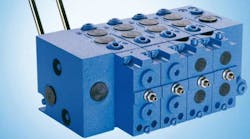In response to my previous post about troubleshooting hydraulic cylinder drift, a couple of our members thought the influence of valve-spool configuration on cylinder drift warranted discussion. Charlie Field from Perry Slingsby Systems in the UK sent me this message:
"By far the most common reason for cylinder drift is the DCV controlling it. Closed to actuator spools almost always leak pressure to both service ports. If you effectively plug the actuator lines with gauges you will see something like 30% to 50% of the "P" line pressure in the actuator lines."
This CAN be a problem with closed-center cylinder spools (all ports blocked in the center position) when the pump is not unloaded. Another member posed the question this way:
"How about a horizontally mounted cylinder powered by a pressure compensated pump at 3,000 PSI and using an all ports blocked center condition valve? Will that cause the cylinder to drift?"
You can almost bet it will. As you've probably gathered this has nothing to with the integrity of the cylinder's piston seal - which we were talking about in last week's post. It's due to the radial clearance of the spool.
Because radial clearance is required for the spool to slide in its bore, this valve design is not leak free. To say this another way, even when a port in a spool valve is closed off - a small amount of leakage should be expected.
Whereas the other main valve design used in hydraulics - the poppet type, where the valve 'poppet' closes against a seat IS generally considered leak free. That is, if the valve is closed and the poppet and its seat are in good condition - there is no leakage across the valve's ports.
BUT there's an important exception to this rule. Slip-in cartridge valves, also called logic elements are a type of poppet valve commonly found in today's hydraulic systems. Even though a logic element can be configured for flow in two directions, it is only leak free in one direction.
Getting back to cylinder drift caused by the radial clearance of the directional control valve spool, if the pump can't be unloaded then a float center spool (A and B open to T) with load holding check or counterbalance valves is the typical solution.
Bottom line: blaming a leaking piston seal for cylinder drift when it's being caused by spool valve leakage is a common mistake. And to discover six other costly mistakes you want to be sure to avoid with your hydraulic equipment, get "Six Costly Mistakes Most Hydraulics Users Make... And How You Can Avoid Them!" available for FREE download here.

Continue Reading
Continue Reading
Sponsored Recommendations
Sponsored Recommendations
How Variable Volume Pumps Work
Feb. 6, 2024
What is a Check Valve and How Does it Work?
Feb. 6, 2024
